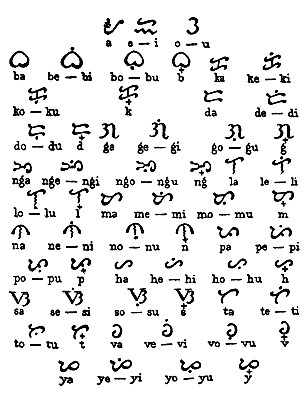Most scholars are reluctant to give an origin for the scripts, but they have been compared to the Indic writings in the Edicts of Asoka (500BC), the Batak scripts in Sumatra, and the Buginese scripts in Celebes-- all remarkably different from the Philippine scripts.
The syllabary to the right is an example of the Ilocano script, taken from the 1621 Ilocano Doctrina Cristiana by Father Belarmino. Very few examples of the script as employed on Luzon Island are still available today, but we do have samples of old nineteenth century Filipino signatures employing both Roman characters and the native script.
The Tagalog syllabary is essentially the same as the Ilocano syllabary, a nice example of it also occurs in the Povedano calendar, taken from the 1572 Povedano manuscript. Its pre-Hispanic origin is dubious, but it is nevertheless quite pretty to look at.

